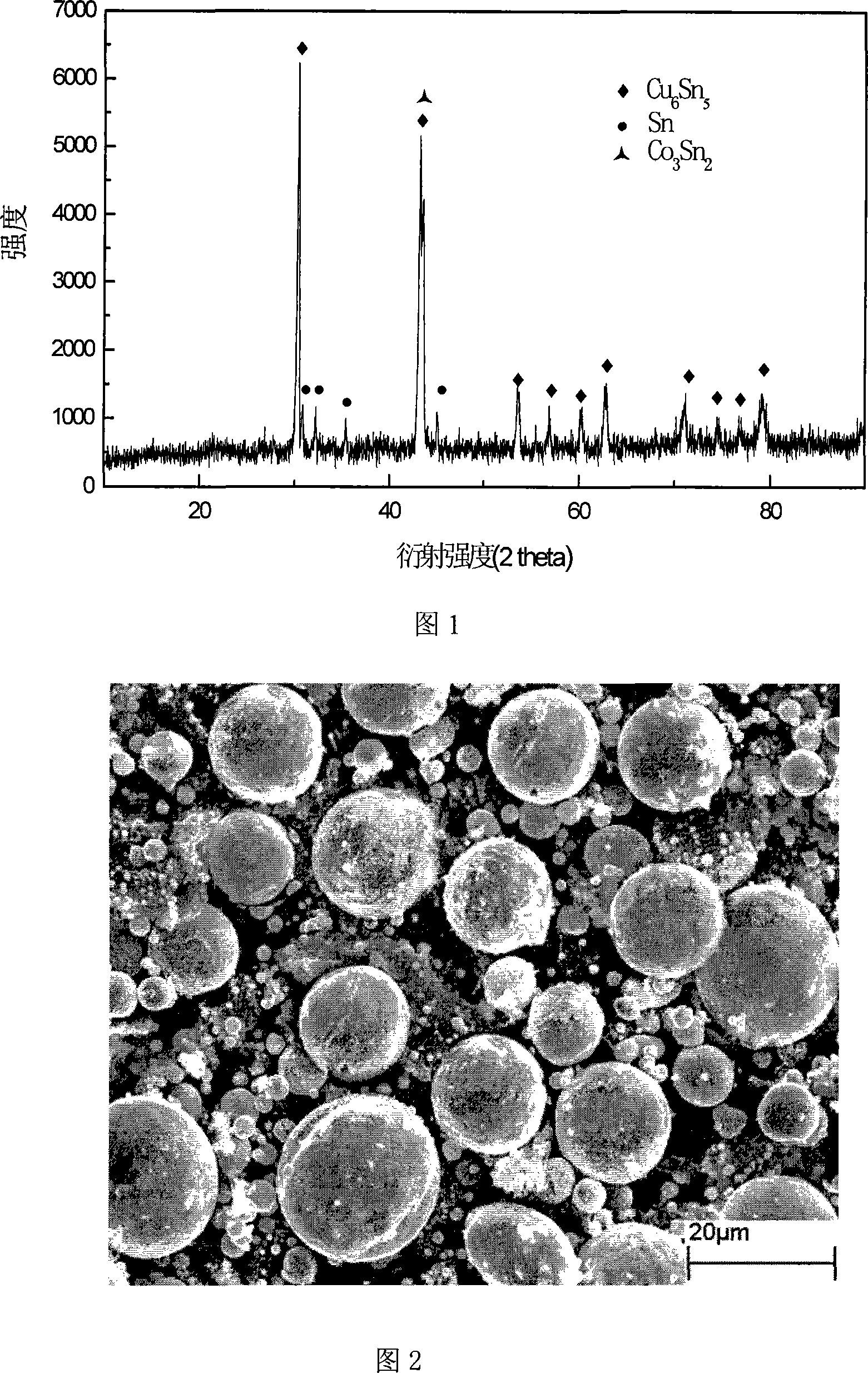Production method for tin-copper-cobalt ternary alloy cathode material of lithium ion battery
A technology for lithium ion batteries and negative electrode materials, which is applied in battery electrodes, electrical components, circuits, etc., can solve the problems of affecting the charge-discharge cycle stability of electrodes, unsatisfactory cycle stability performance, and damage to the structure of alloy negative electrodes, and achieve large-scale applications. value, improving cycle stability, and the effect of not easy to agglomerate
- Summary
- Abstract
- Description
- Claims
- Application Information
AI Technical Summary
Problems solved by technology
Method used
Image
Examples
Embodiment 1
[0021] Accurately weigh 1g of SnO, 0.1476g of CuO, 0.1391g of CoO, and 0.1338g of activated carbon as initial raw materials (the molar ratio of raw materials is 4:1:1:10, equivalent to the atomic ratio of Sn / Cu / Co being 4:1:1), After grinding the mixture evenly, place it in a flowing nitrogen atmosphere and raise the temperature to 1000°C at a rate of 10°C / min, keep it warm for 3 hours, then turn off the power, and cool naturally to room temperature to obtain a tin-copper-cobalt alloy.
Embodiment 2
[0023] Accurately weigh 1g SnO 2 , 0.5279g CuO, 0.1065gCo 3 o 4 , and 0.2604g activated carbon as the initial raw material (raw material molar ratio 15: 15: 1: 49, equivalent to the atomic ratio of Sn / Cu / Co is 5: 5: 1), after the mixture is ground evenly, it is placed in flowing argon Raise the temperature to 900°C at a rate of 5°C / min in an air atmosphere, keep it warm for 2 hours, then turn off the power, and cool naturally to room temperature to obtain a tin-copper-cobalt alloy. The XRD phase analysis result of gained sample shows that the synthetic product is Cu 6 sn 5 , Sn and Co 3 sn 2 Alloy composite without any oxide impurity phase.
[0024] Add 10wt% conductive agent acetylene black and 10wt% binder PVDF to the synthesized material to make a slurry, apply it evenly on the copper foil, and after drying, stick it into a circular pole piece. The lithium sheet is used as the negative electrode, and the resulting pole piece is used as the positive electrode. The ele...
Embodiment 3
[0026] Accurately weigh 1g SnO 2 , 0.2374g Cu 2 O, 0.2486gCoO, and 0.2192g carbon black are used as initial raw materials (the molar ratio of raw materials is 4:1:2:11, the atomic ratio equivalent to Sn / Cu / Co is 2:1:1), after the mixture is ground evenly, set Raise the temperature to 800°C at a rate of 2°C / min in a flowing argon atmosphere, keep it warm for 2 hours, then turn off the power, and cool naturally to room temperature to obtain a tin-copper-cobalt alloy. The XRD phase analysis result of gained sample shows that the synthetic product is Cu6 sn 5 and Co 3 sn 2 Alloy composite without any oxide impurity phase.
PUM
 Login to View More
Login to View More Abstract
Description
Claims
Application Information
 Login to View More
Login to View More - R&D
- Intellectual Property
- Life Sciences
- Materials
- Tech Scout
- Unparalleled Data Quality
- Higher Quality Content
- 60% Fewer Hallucinations
Browse by: Latest US Patents, China's latest patents, Technical Efficacy Thesaurus, Application Domain, Technology Topic, Popular Technical Reports.
© 2025 PatSnap. All rights reserved.Legal|Privacy policy|Modern Slavery Act Transparency Statement|Sitemap|About US| Contact US: help@patsnap.com

